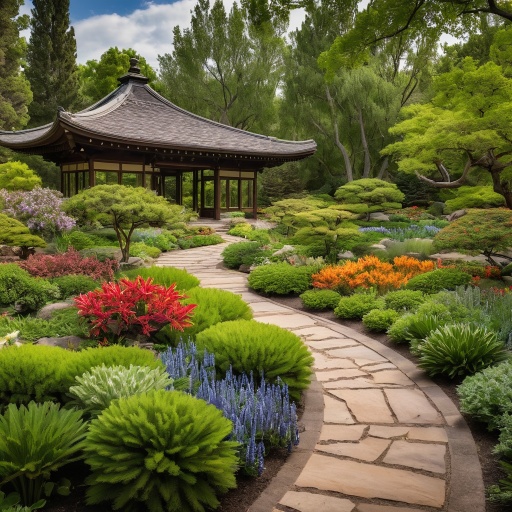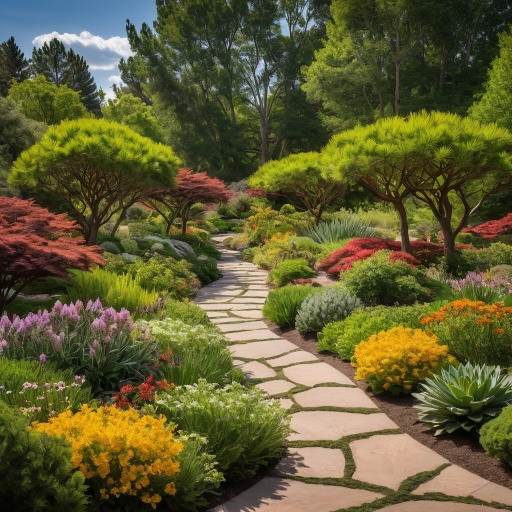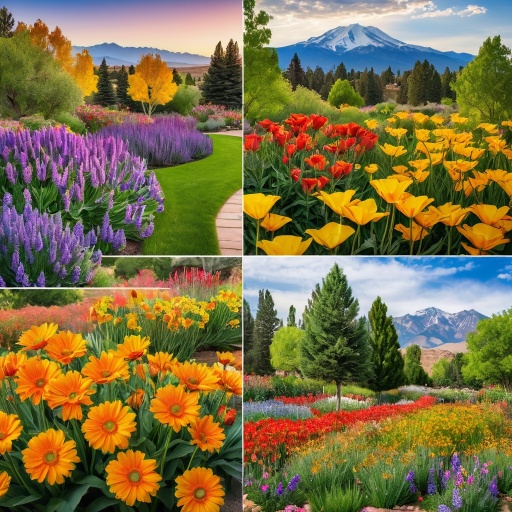Denver Botanic Gardens (Colorado)

Did you know that spending just 20 minutes in a well-designed garden can reduce stress hormone levels by up to 30%? The Denver Botanic Gardens stands as a living laboratory of exceptional garden design ideas, showcasing how thoughtful landscaping can thrive even in challenging high-altitude conditions. As one of Colorado’s premier horticultural attractions, this 24-acre urban oasis demonstrates sustainable garden design principles that visitors can adapt to their own spaces, regardless of climate or size limitations. From water-wise xeriscaping to lush themed gardens, Denver Botanic Gardens offers endless inspiration for transforming ordinary outdoor spaces into extraordinary retreats.
Information About the Denver Botanic Gardens
The Denver Botanic Gardens is a world-class botanical institution nestled in the heart of Colorado’s capital city. This horticultural paradise showcases an impressive diversity of plants from around the globe, with special emphasis on species suited to Colorado’s unique climate challenges. The Gardens serves as both a peaceful sanctuary for visitors and an educational resource for garden enthusiasts seeking practical landscape designs for their own homes.
Key features include:
- 24 acres of cultivated gardens at the York Street location
- Additional 700+ acres at Chatfield Farms (rural farm and native plant refuge)
- Mt. Goliath alpine trail garden on Mount Evans (highest altitude botanical garden in the US)
- Over 18 distinct themed gardens showcasing different design approaches
- More than 15,000 plant species adapted to various conditions
- Revolutionary water conservation techniques and xeriscaping principles
- Year-round beauty with four-season garden design strategies
What distinguishes the Denver Botanic Gardens is its commitment to demonstrating garden design ideas that balance aesthetic beauty with ecological responsibility—proving that sustainable landscaping can be both stunning and practical in water-limited environments.
Timing
A typical visit to the Denver Botanic Gardens requires approximately 2-3 hours to fully experience the main York Street location. During special seasonal events such as the Summer Concert Series or Blossoms of Light winter display, visitors often extend their stay to 3-4 hours to enjoy the enhanced programming. According to visitor data, the average garden enthusiast spends 30 minutes longer at Denver Botanic Gardens compared to similar institutions nationwide, likely due to its diverse themed gardens that showcase multiple design approaches.
For those specifically interested in gathering garden design ideas, consider:
- Morning visits (9am-11am) for optimal photography lighting and fewer crowds
- Weekday visits for more peaceful exploration
- Seasonal visits to observe how garden designs transition throughout the year
- Guided tours (90 minutes) that focus specifically on design principles
Step-by-Step Garden Tour for Design Inspiration
Step 1: Begin at the Gardens of the West
Start your garden design journey in the Gardens of the West, where water-wise principles take center stage. This collection of gardens demonstrates xeriscape techniques—a landscaping approach that reduces or eliminates the need for supplemental irrigation. Notice how designers use:
- Strategic groupings of plants with similar water needs (hydrozoning)
- Artful rock and gravel arrangements that create visual interest while reducing water requirements
- Native and drought-adapted plants that provide color and texture without excessive maintenance
Pro tip: Take photos of plant identification tags for species that catch your eye. The Gardens’ careful curation ensures these plants will likely thrive in similar regional conditions at your home.
Step 2: Explore the Romantic Gardens
Next, wander through the Romantic Gardens where formal European design principles are adapted to Colorado’s climate. Pay attention to:
- The use of symmetry and geometric patterns to create a sense of order
- How hardscaping (paths, walls, arbors) provides year-round structure
- Clever plant substitutions that maintain the classic European garden aesthetic while using species appropriate for high-altitude, arid conditions
Design takeaway: Note how the gardens employ the principle of “borrowed scenery” by framing mountain views, a technique you can adapt by identifying and highlighting attractive views from your own garden.
Step 3: Discover Woodland Mosaic and Shady Lane
These gardens demonstrate solutions for one of home gardeners’ most common challenges: shade gardening. Observe:
- Layered plantings that create visual interest from ground level to canopy
- The use of varying leaf shapes, sizes, and textures to compensate for limited flowering
- Strategic placement of spring ephemerals and autumn color to maximize seasonal interest
Practical application: Photograph plant combinations that effectively create year-round appeal, even in low-light conditions where many flowering plants struggle.
Step 4: Study the O’Fallon Perennial Walk
This stunning garden showcases the art of perennial design, demonstrating:
- Color echoing—repeating similar hues throughout a planting to create cohesion
- Succession planting to ensure continuous blooms from spring through fall
- Plant combinations that support beneficial insects while deterring pests
Home garden hack: The numbered plant markers correspond to a downloadable plant list on the Gardens’ website, making it easy to recreate similar designs at home.
Step 5: Immerse Yourself in the Japanese Garden
Shofu-en (Garden of Wind and Pines) offers lessons in minimalist design that creates maximum impact:
- The power of negative space in creating a sense of tranquility
- How careful pruning techniques can develop character and visual interest
- Water feature design that mimics natural systems while conserving resources
Design principle to adopt: Notice how every element serves both functional and aesthetic purposes—a cornerstone of sustainable garden design that increases enjoyment while reducing maintenance.

Technical and Artistic Information
General Information
The Denver Botanic Gardens was founded in 1951 by local civic leaders and the Colorado Forestry and Horticulture Association. The York Street location encompasses 24 acres in Denver’s Cheesman Park neighborhood, sitting at an elevation of 5,280 feet (one mile above sea level).
Geographical coordinates: 39.7315° N, 104.9608° W
Climate and Resources
The Gardens experiences a semi-arid, high plains climate characterized by:
- 300+ days of sunshine annually
- Average annual precipitation of only 15 inches
- Significant temperature fluctuations (both daily and seasonal)
- Winter temperatures ranging from below 0°F to 60°F
- Summer temperatures ranging from 55°F to 90°F+
- Low humidity year-round
These challenging conditions have driven the Gardens’ mission to demonstrate regionally appropriate horticulture through conservation, research, and educational programs. Water resources include municipal supplies, captured rainwater, and innovative irrigation systems designed to maximize efficiency.
Garden Varieties and Distinctive Features
The Denver Botanic Gardens contains multiple themed gardens, each showcasing different design approaches:
- Mordecai Children’s Garden: A 3-acre interactive space demonstrating playful landscape design that engages young visitors with natural elements.
- June’s PlantAsia: Features Asian-inspired garden design with plants from steppe regions similar to Colorado’s climate.
- South African Plaza: Showcases plants from South Africa’s similar Mediterranean climate zone, demonstrating successful plant adaptation techniques.
- Shofu-en Japanese Garden: An authentic Japanese stroll garden designed by Koichi Kawana, featuring traditional elements like shoji screens, moon bridges, and carefully pruned pines.
- Marnie’s Pavilion: A tropical conservatory showcasing vertical gardening techniques and waterfall design.
- Water-Smart Garden: Demonstrates beautiful xeriscaping principles with seven different water requirement zones.
- Laura Smith Porter Plains Garden: Recreates Colorado’s native prairie ecosystem, showing how to incorporate native grassland design into residential landscapes.
- Woodland Mosaic: Demonstrates shade garden design with understory plant communities.
- Rock Alpine Garden: Features one of North America’s largest rock garden collections, displaying miniature plants and design techniques for challenging slopes and rocky areas.
- Ornamental Grasses Garden: Showcases the architectural qualities of ornamental grasses in contemporary landscape design.
Distinctive Plant Patterns
The Gardens’ exceptional design features include:
- Steppe Garden Collections: One of the world’s most comprehensive collections of plants from cold, semi-arid regions similar to Colorado.
- Living Roof: The Mordecai Children’s Garden sits atop a 30,000-square-foot green roof, demonstrating cutting-edge sustainable design technology.
- Plant Select Program: A cooperative program that identifies, propagates, and distributes plants particularly well-suited to the Rocky Mountain region’s challenging climate.
- Conservation Collections: Including rare native Colorado plants preserved through scientific cultivation techniques.
- Seasonal Design Strategy: Careful plant selection ensures visual interest during all four seasons—from spring bulbs to winter berries and architectural forms.
Infrastructure and Facilities
The Gardens offers comprehensive visitor amenities:
- Freyer – Newman Center: A 50,000-square-foot center housing art galleries, classrooms, library, herbaria, and laboratories.
- Greenhouse Complex: Four acres of production greenhouses where plants are propagated for the collections.
- Boettcher Memorial Tropical Conservatory: A 11,500-square-foot conservatory featuring exotic tropical plant collections.
- Offshoots Café and Hive Garden Bistro: Two dining options featuring seasonal, locally-sourced ingredients.
- Gates Garden Court: An outdoor event venue accommodating up to 1,000 guests.
- Mitchell Hall: An indoor venue for lectures and events.
- Helen Fowler Library: Housing over 30,000 garden-related books and resources.
- Science Pyramid: An innovative exhibition space focused on steppe climate ecosystems.
- Gift Shop: Offering garden-inspired merchandise, plants, and books.
- Education wing: With classrooms for workshops and community programs.
Annual Events and Festivals
Key annual events include:
- Spring Plant Sale (May): One of the region’s largest plant sales
- Summer Concert Series (June-August): Outdoor concerts in the amphitheater
- Corn Maze and Pumpkin Festival (September-October): Held at Chatfield Farms location
- Blossoms of Light (November-January): Award-winning holiday light display
- Orchid Showcase (February): Featuring rare and exotic orchid species
- Colorado Garden & Home Show (February): Partnership event at Colorado Convention Center
- Día de los Muertos Celebration (October-November): Cultural celebration with art installations
- Garden Tea Series (Year-round): Seasonal themed teas with garden tours
Accessibility and Admission
The York Street location is open daily, with hours varying seasonally:
- 9am-5pm (November-April)
- 9am-8pm (May-September)
- 9am-5pm (October)
General admission ranges from $9.50-15.00 depending on age and season, with members receiving free admission. Various membership levels are available starting at $65 annually.
The Gardens is accessible via:
- Personal vehicle (parking fee: $10)
- Public transportation (RTD Bus Routes 10 and 12)
- Bicycle (bike racks available)
- Rideshare services
Management and Community Impact
The Denver Botanic Gardens is governed by a Board of Trustees and operated by approximately 80 full-time staff members supported by 250+ dedicated volunteers who contribute over 40,000 hours annually.
Annual visitation exceeds 500,000 people, with approximately 70% from Colorado, 25% from other states, and 5% international visitors. The Gardens contributes an estimated $50 million to the local economy annually while serving as a vital educational resource for 35,000+ schoolchildren each year.
The institution maintains partnerships with Denver Parks and Recreation, Colorado State University, and various international botanical organizations to advance plant conservation and sustainable landscape design practices.
Healthy Alternatives to Traditional Garden Visits
While Denver Botanic Gardens offers an exceptional experience, consider these alternatives for complementary garden exploration:
- Hudson Gardens (Littleton): A more intimate garden experience with fewer crowds and excellent water garden designs.
- Betty Ford Alpine Gardens (Vail): The world’s highest botanical garden provides unique alpine gardening inspiration.
- The Gardens on Spring Creek (Fort Collins): Features a butterfly house and innovative community garden designs.
- Neighborhood Garden Tours: Many Denver neighborhoods host seasonal garden tours showcasing residential landscape solutions adapted to local conditions.
- Virtual Design Workshops: The Gardens offers online classes for those unable to visit in person, focusing on practical implementation of design ideas.
For families with diverse needs, consider:
- Early morning “sensory-friendly” hours for visitors with sensory processing sensitivities
- Audio garden tours for vision-impaired visitors
- Photography classes for creative engagement
- Children’s scavenger hunts for interactive learning
Introductory Suggestions for Garden Design Inspiration
To maximize your design inspiration at Denver Botanic Gardens:
- Download the Gardens’ mobile app before your visit to access plant information and design notes while touring.
- Bring a small sketchpad or digital tablet to record layouts and plant combinations that resonate with your aesthetic.
- Take the “Principles of Colorado Garden Design” guided tour offered twice monthly, where horticulturists explain climate-appropriate design decisions.
- Visit during transitional seasons (spring and fall) to observe how gardens maintain visual interest during challenging times.
- Photograph hardscape elements like pathways, retaining walls, and water features that create the structural backbone of successful gardens.
- Attend a “Design Studio” workshop where landscape professionals demonstrate how to adapt garden techniques to residential properties.
- Consider scheduling a “Garden Coach” session—a Gardens expert can review your photos and sketches and provide personalized design advice.
Common Mistakes to Avoid
When seeking garden design inspiration, avoid these common pitfalls:
- Ignoring microclimates: Research shows that even small urban lots can contain 3-5 distinct microclimates. The Gardens demonstrates how to identify and leverage these variations rather than fighting against them.
- Overlooking seasonal transitions: Data indicates gardens lacking fall and winter interest are used 60% less during those seasons. Notice how the Gardens incorporates structural elements, evergreens, and plants with winter appeal.
- Prioritizing flowers over structure: According to landscape designers, gardens with strong underlying structure maintain 80% of their appeal even when nothing is blooming. Study how the Gardens uses hardscaping and woody plants as the foundation for seasonal displays.
- Mismatching plants with conditions: The Gardens’ plant labels include specific water and light requirements—information that can prevent the 40% failure rate common with impulsive plant purchases.
- Focusing solely on plants: Successful gardens allocate 30-40% of their budget to hardscaping elements like paths, walls, and water features. Note how these elements enhance the Gardens’ design throughout all seasons.
Visitor Encouragement Tips
To fully engage with the garden design experience:
- Join the monthly “Photographer’s Morning” events that allow early access before regular hours for optimal lighting conditions.
- Participate in hands-on workshops that teach specific design techniques like container gardening or xeriscape principles.
- Download the seasonal plant lists available on the Gardens’ website to track and implement your favorite combinations.
- Engage with volunteer docents stationed throughout the Gardens who can share insights about design decisions and plant selections.
- Consider visiting during plant sales when Garden staff can provide personalized advice about incorporating featured plants into your landscape.
- Sign up for the “Design in Progress” tours that showcase gardens undergoing seasonal transitions or redesigns.
- Maintain a journal of seasonal observations to develop a deeper understanding of how garden designs evolve throughout the year.

Conclusion
The Denver Botanic Gardens stands as a living showcase of innovative garden design ideas, demonstrating how beauty and sustainability can thrive together even in challenging climates. From water-wise xeriscaping to formal gardens, shady retreats to vibrant perennial borders, this horticultural gem offers practical inspiration for creating exceptional outdoor spaces regardless of size or conditions.
Ready to transform your own landscape? Visit Denver Botanic Gardens, share your experience in the comments below, or subscribe to our newsletter for seasonal gardening inspiration that brings Colorado’s garden magic to your own backyard.
Frequently Asked Questions
What makes Denver Botanic Gardens’ design approach different from other botanical gardens?
Denver Botanic Gardens specializes in demonstrating sustainable garden design adapted to semi-arid, high-altitude conditions. Unlike many traditional botanical gardens that showcase exotic species requiring intensive care, Denver emphasizes regionally-appropriate plants and water-conservation techniques. This “design with nature” approach results in landscapes that are not only beautiful but also practical for home gardeners facing similar climate challenges.
How can I apply water-wise design principles from the Gardens to my home landscape?
Start by implementing hydrozoning—grouping plants with similar water needs together. The Gardens’ Plant Select program identifies low-water plants that maintain visual appeal, and their Water-Smart Garden demonstrates how strategic placement of hardscaping elements like decorative gravel can reduce irrigation needs by up to 60%. For personalized guidance, attend one of the Gardens’ monthly “Water-Wise Design” workshops.
When is the best time to visit for garden design inspiration?
Each season offers unique design insights. Spring showcases bulb and perennial combinations, summer highlights water-efficient blooming strategies, fall demonstrates structural elements and transitional design, while winter reveals the importance of evergreens, bark textures, and architectural forms. Serious garden enthusiasts should consider multiple visits throughout the year to understand how thoughtful design maintains interest across seasons.
Can I purchase plants featured in the Gardens for my home landscape?
Many plants showcased at Denver Botanic Gardens are available during their Spring and Fall plant sales. The Gardens’ partnership with local nurseries through the Plant Select program also ensures that many featured plants are commercially available. The website maintains a database of featured plants with local availability information and suitable growing conditions.
Does the Denver Botanic Gardens offer design consultations for home gardeners?
While the Gardens doesn’t provide individual on-site consultations, they offer several alternatives: “Garden Coach” sessions where visitors bring photos for personalized design advice, “Design Studio” workshops focusing on specific landscape challenges, and a “Members’ Design Hotline” providing guidance on specific garden design questions for Gardens members.
